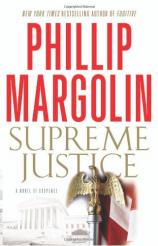Supreme Justice
Review
Supreme Justice
Philip Margolin’s recent novels haven’t entirely abandoned the mystery/legal/police procedural elements that those who have been following him for these past several years have grown to love. However, the political element that has been interjected into his plots of late have been unrealistic to the point of being painfully contrived in his latest effort, SUPREME JUSTICE. Fortunately, the heart of the book --- a puzzling murder mystery --- makes it worth reading.
The political half of the SUPREME JUSTICE equation involves an attack on Felicia Moss, a Supreme Court justice who is in the position of providing the swing vote concerning a writ of certiorari, or request for review, of a death penalty case. Sarah Woodruff, a Portland, Oregon police officer, has been convicted of murdering her lover, John Finley. The appeal is based upon the obligation of the district attorney’s office to disclose evidence to Woodruff’s lawyer that may be favorable to her and crucial to her defense. The evidence, though, has been deemed critical to homeland security issues and thus cannot be revealed. What we do know is that it concerns actions performed by a rogue element of the CIA that does not want revelations about those actions to see the light of day.
Just before the Court is to decide whether or not to grant the writ, one of its justices suddenly retires. Moss, another justice who is believed will be a deciding vote in favor of granting the writ, is also brutally attacked, though her life is saved at the last moment by Brad Miller, her clerk, who was last seen in EXECUTIVE PRIVILEGE bringing the President down. At the same time, the people behind the attack on Moss are attempting to force the appointment of a Supreme Court justice more sympathetic to denying the writ, which will keep the evidence of the agency’s wrongdoing under wraps.
If all of this seems somewhat familiar, it is, and unfortunately it ultimately exceeds one’s ability to suspend disbelief until the end of the novel. The act of attacking a Supreme Court judge would not be a blip on the news radar. The news media and everyone else would immediately begin asking why, and the very secret one was trying so hard to keep would be revealed when the justice’s caseload was scrutinized. Perhaps Margolin realized this and intended Miller’s unintentionally hilarious remarks --- “I can’t imagine that there will ever be another term of the United States Supreme Court like this one” --- near the end of the book to be self-deprecating.
That said, all is not lost here by any means. The mystery half of SUPREME JUSTICE makes for riveting reading. This consists of the events leading up to the murder investigation (make that two investigations, actually: Woodruff’s arrest, and the trial that results in the court appeal). It begins in 2006, when Woodruff is initially charged with killing Finley. There is plenty of circumstantial evidence: blood in Woodruff’s residence, her gun was fired, neighbors heard them fighting, and Finley is missing. The only problem is that no one is sure that Finley is dead. Max Dietz, the assistant district attorney with jurisdiction over the investigation, is too eager to charge Woodruff --- in part for personal reasons. His folly is revealed dramatically and with much embarrassment to him before the case is even brought to trial. Woodruff is freed and tries to put her life back together.
When Finley’s butchered body is subsequently discovered some two years later, however, Woodruff is again charged with his murder, and on this second occasion is tried and convicted, resulting in her death row appeal. Dana Cutler, the brilliant and enigmatic investigator from EXECUTIVE PRIVILEGE, is brought in by Miller to determine why a murder case in Oregon is causing shockwaves in Washington, D.C. Cutler, an unforgettable character who is underutilized in SUPREME JUSTICE, discovers the answer, and more, which is revealed in a climax that twists, turns, and twists again in ways that you might never guess.
While Margolin has written better books than SUPREME JUSTICE, there are enough surprises here to satisfy everyone, and his sharp mystery plotting and interesting characters --- particularly Cutler --- make this one worth reading. Here’s hoping that he focuses more on mystery and suspense in his next work, and beyond.
Reviewed by Joe Hartlaub on January 24, 2011





